
What a Doll!
Sometimes, the Ragdoll will let you cuddle her, just like a doll! This means she's got traits like:
- Good with children and other pets
- Mild-mannered and easy to get along with
- Docile and devoted
But she definitely has some maintenance needs to consider:
- Long coat needs to be brushed regularly
- Can become overweight easily if not exercised regularly
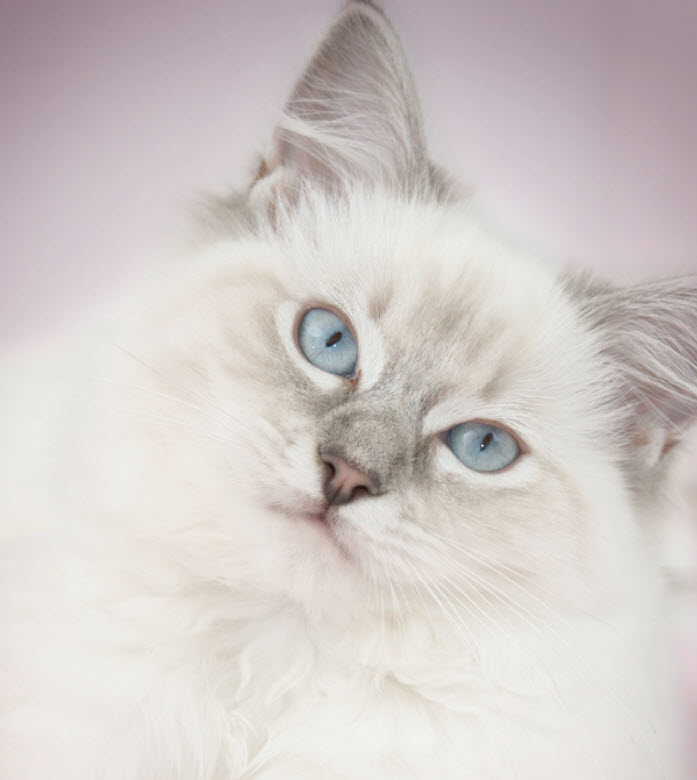 Is it all worth it? Of course! She's full of personality, and you love her for it! She is affectionate and easygoing, an excellent companion for the whole family.
Is it all worth it? Of course! She's full of personality, and you love her for it! She is affectionate and easygoing, an excellent companion for the whole family.
Ragdolls were developed in the 1960’s by a breeder in California, who sought after cats with a specific look and docile temperament to create the breed. Their soft, medium length coat comes in six colors: seal, blue, chocolate, lilac, red, and cream. Mild-mannered and friendly, Ragdolls get along well with children and other pets. Ragdolls are one of the largest cat breeds and tend to spend most of their time on the floor, instead of in high places.
Your Ragdoll's Health
We know that because you care so much about your cat, you want to take great care of her. That is why we have summarized the health concerns we will be discussing with you over the life of your Rag. By knowing about the health concerns common among Ragdolls, we can help you tailor an individual preventive health plan and hopefully prevent some predictable risks in your pet.
Many diseases and health conditions are genetic, meaning they are related to your pet’s breed. The conditions we will describe here have a significant rate of incidence or a strong impact upon this breed particularly, according to a general consensus among feline genetic researchers and veterinary practitioners. This does not mean your cat will have these problems, only that she may be more at risk than other cats. We will describe the most common issues seen in Ragdolls to give you an idea of what may come up in her future. Of course, we can’t cover every possibility here, so always check with us if you notice any unusual signs or symptoms.
This guide contains general health information important to all felines as well as information on genetic predispositions for Ragdolls. The information here can help you and your pet’s healthcare team plan for your pet’s unique medical needs together. At the end of the article, we have also included a description of what you can do at home to keep your Doll looking and feeling her best. We hope this information will help you know what to watch for, and we will all feel better knowing that we’re taking the best possible care of your friend.
General Health Information for your Ragdoll
Weight Management
Obesity is a major disease that contributes to a surprisingly large number of illnesses and deaths in cats.
This revelation is more well-known and well-understood today than in the last few decades, but too many owners are still ignoring the dangers of extra weight on their pets. Excess weight is one of the most influential factors in the development of arthritis, diabetes, and other life-threatening diseases. Everyone knows—many firsthand from personal experience—how even shedding just a few pounds can result in improved mobility and increased overall motivation to be active. And the same is true for your pet.
Research suggests that carrying excess weight may shorten a pet’s life by as much as two years, and can cause the onset of arthritis two years sooner. Diabetes, an inherited disease, has a much higher chance of developing in overweight pets, and may never become a problem for a healthy-weight cat. The more obese a cat becomes, the more likely it will become diabetic. Hepatic lipidosis, or fatty liver, is another potentially fatal disease in overweight pets; hepatic lipidosis can develop in as few as 48 hours when an overweight cat stops eating for any reason.
So how can we help our pets stay trim? Understanding your cat's dietary habits is key. The average cat prefers to eat about 10-15 times a day, just a few nibbles at a time. This method, free-feeding, works well for most cats, but boredom may increase the number of trips your cat makes to the food bowl. By keeping your cat playfully active and engaged, you'll help your pet stay healthy and have some fun at the same time! A string tied to a stick with something crinkly or fuzzy on the other end of the string, and a little imagination—you and your cat will both be entertained. Food puzzles, like kibbles put in a paper bag or under an overturned basket or box, may help to motivate cats with more food-based interests to romp and tumble.
For really tough cases of overeating, you will have to take a firm stance, and regulate your cat’s food intake. Instead of filling your cat’s bowl to the top, follow the feeding guide on the food package and be sure to feed a high-quality adult cat diet as recommended by your vet. Replace your cat's habits of eating when bored with extra playtime and affection. Cats typically adjust their desires for personal interaction by the amount of affection offered to them, so in other words, ignoring your cat means your cat will ignore you. By the same token, loving on and playing with your cat a lot will cause your cat to desire that time with you. A more active cat means a healthier, happier pet—and owner!
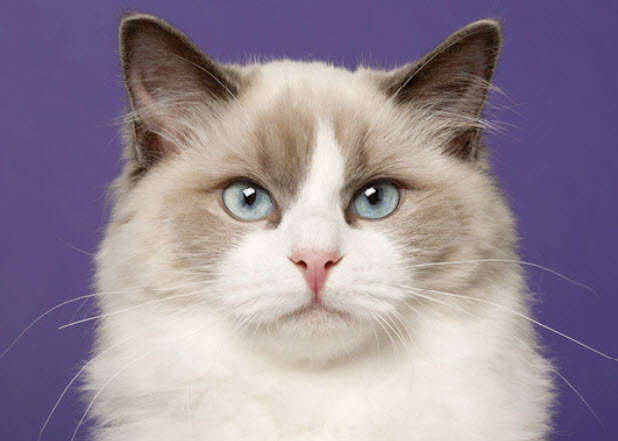 Dental Disease
Dental Disease
Dental disease is one of the most common chronic problems in pets who don’t have their teeth brushed regularly. Unfortunately, most cats don’t take very good care of their own teeth, and this probably includes your Rag. Without extra help and care from you, your cat is likely to develop potentially serious dental problems. Dental disease starts with food residue, which hardens into tartar that builds up on the visible parts of the teeth, and eventually leads to infection of the gums and tooth roots. Protecting your cat against dental disease from the start by removing food residue regularly may help prevent or delay the need for advanced treatment of dental disease. This treatment can be stressful for your cat and expensive for you, so preventive care is beneficial all around. In severe cases of chronic dental infection, your pet may even lose teeth or sustain damage to internal organs. And, if nothing else, your cat will be a more pleasant companion not knocking everyone over with stinky cat breath! We’ll show you how to keep your cat's pearly whites clean at home, and help you schedule regular routine dental exams.
Vaccine-Preventable Infections
Like all cats, Ragdolls are susceptible to bacterial and viral infections such as panleukopenia, calicivirus, rhinotracheitis, and rabies, which are preventable through vaccination. The risk of your cat contracting these diseases is high, so the corresponding vaccines are called “core” vaccines, which are highly recommended for all cats. In addition, vaccines are available to offer protection from other dangerous diseases like feline leukemia virus (FeLV). In making vaccination recommendations for your cat, we will consider the prevalence of these diseases in our area, your cat’s age, and any other risk factors specific to her lifestyle.
Parasites
All kinds of worms and bugs can invade your Doll's body, inside and out. Everything from fleas and ticks to ear mites can infest her skin and ears. Hookworms, roundworms, heartworms, and whipworms can get into her system in a number of ways: drinking unclean water, walking on contaminated soil, or being bitten by an infected mosquito. Some of these parasites can be transmitted to you or a family member and are a serious concern for everyone. For your feline friend, these parasites can cause pain, discomfort, and even death, so it’s important that we test for them on a regular basis. Many types of parasites can be detected with a fecal exam, so it’s a good idea to bring a fresh stool sample (in a stink-proof container, please) with your pet for her twice-a-year wellness exams. We’ll also recommend preventive medication as necessary to keep her healthy.
Spay or Neuter
One of the best things you can do for your Rag is to have her spayed (neutered for males). In females, this procedure includes surgically removing the ovaries and usually the uterus; in males, the testicles are surgically removed. Spaying or neutering your pet decreases the likelihood of certain types of cancers and eliminates the possibility of your pet becoming pregnant or fathering unwanted litters. Both sexes usually become less territorial and less likely to roam, and neutering particularly decreases the occurrence of urine spraying and marking behaviors in males. Performing this surgery also gives us a chance, while your pet is under anesthesia, to identify and address some of the diseases your cat is likely to develop. For example, if your pet needs hip X-rays to check for dysplasia or a thorough dental exam to look for stomatitis, these procedures can be conveniently performed at the same time as the spay or neuter to minimize the stress on your cat. Routine blood testing prior to surgery also helps us to identify and take precautions against common problems that increase anesthetic or surgical risk. It sounds like a lot to keep in mind, but don’t worry - we’ll discuss all the specific problems we will look for with you when the time arrives.
Genetic Predispositions for Ragdolls
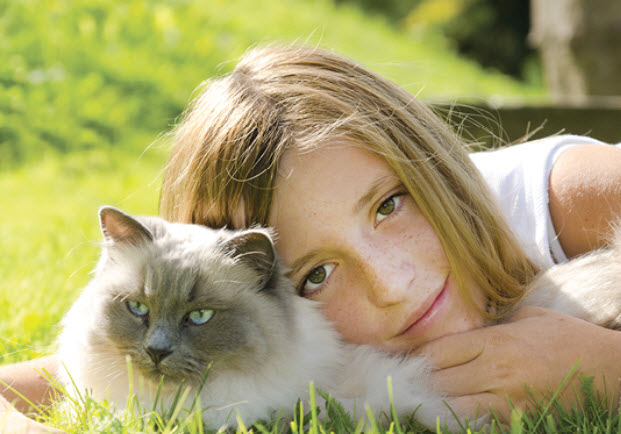 Heart Disease
Heart Disease
Cardiomyopathy is the medical term for heart muscle disease, either a primary inherited condition or secondary to other diseases that damage the heart. The most common form, called hypertrophic cardiomyopathy, or HCM, is a thickening of the heart muscle often caused by an overactive thyroid gland. Another example is dilated cardiomyopathy, or DCM, which can be caused by a dietary deficiency of the amino acid taurine. While DCM was a big problem in the past, all major cat food producers now add taurine to cat food, so DCM is rarely seen in cats with high-quality diets today.
Catching signs of cardiomyopathy early is important, but a cat's normal tendency to hide illness can make symptoms difficult to spot. The first thing a pet parent usually notices is rapid breathing, lethargy, and a poor appetite. These symptoms may appear to come on suddenly, often between a few hours to a few days, but in most cases, the cat has actually been suffering quietly for weeks to months and is now in serious trouble. In addition, HCM can cause blood clots to form inside the heart. These clots can then leave the heart and become lodged in the major arteries that transport blood to the rear legs. If this happens, the cat will suddenly lose the use of both rear legs and the tail—the legs will become cold to the touch and will seem extremely painful. In either case, whether rapid breathing or painful paralysis, the cat is experiencing a medical emergency, and needs immediate veterinary care.
For a few breeds of cats, genetic testing is available for a specific gene abnormality that causes HCM. Most cats with cardiomyopathy have a heart murmur that can be detected during a wellness physical exam, but a specific diagnosis requires more advanced medical imaging. Finding this problem early, when treatment is most effective, is another important reason to have your pet evaluated twice a year for life.
Arterial Thromboembolism
Cats with heart disease may develop blood clots in their arteries known as FATE (feline aortic thromboembolisms). Blood clots most commonly become lodged just past the aorta, the large blood vessel that supplies blood from the heart to the body, blocking normal blood flow to the hind legs. When this happens, one or both hind legs may become paralyzed, cold, or painful. FATE is a life-threatening disease, and requires quick action and prolonged medical care. Cats who survive thromboembolisms, however, usually regain full function of their limbs. If your cat is diagnosed with heart disease, we may prescribe medications to help lower the risk of blood clots. If your cat suddenly can’t walk or is dragging one or both back legs and crying, don’t wait! Your pet needs immediate emergency care.
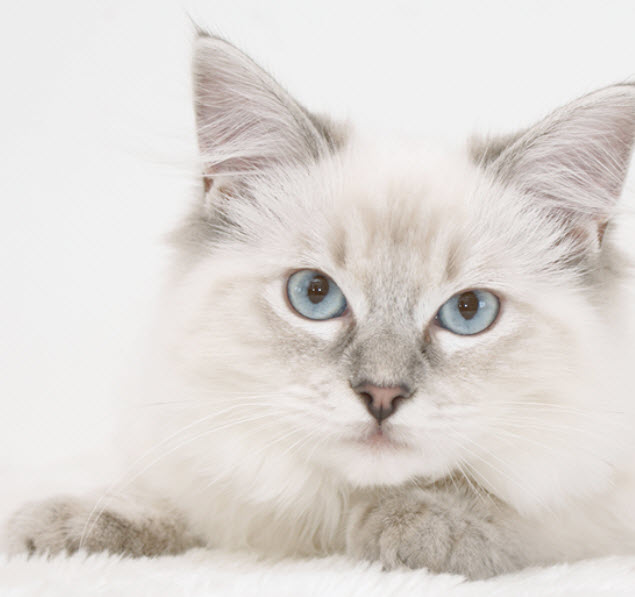 Blood Type
Blood Type
Although we hate to think of the worst happening to our pets, when disaster strikes, it’s best to be prepared. One of the most effective life-saving treatments available in emergency medicine today is the use of blood transfusions. If your cat is ever critically ill or injured and in need of a blood transfusion, the quicker the procedure is started, the better the pet's chance of survival.
Just like people, individual cats have different blood types. Most domestic cats have type A blood, but purebred cats, like your Ragdoll often have a different blood type, usually type B or very rarely, type AB. Determining your cat's blood type is essential before starting a transfusion, so knowing your cat’s type ahead of time can save crucial minutes. Blood typing is recommended for all cats, but is especially important for purebreds. This test can be done as part of a routine wellness blood testing, and the results can be added to your pet's microchip record as well for fast action even if you aren't there.
Polycystic Kidney Disease
Polycystic kidney disease (PKD) is caused by a defective gene. The disease was first recognized in Persians, and is seen occasionally in other breeds, including Ragdolls. Affected kittens are born with miniscule cysts inside the kidneys and sometimes the liver that slowly enlarge over time, eventually destroying the affected organ. Symptoms usually become apparent around seven years of age on average. These symptoms include weight loss, vomiting, excessive thirst, and poor overall health. There is no cure for PKD, although special diets and medication can slow the progress of the resulting organ failure; diagnosing PKD as early as possible may allow effective support of kidney and liver function for years. Routine annual urine or blood testing is therefore recommended to monitor for early organ dysfunction in all adult cats. If PKD is indicated, an ultrasound exam of the abdomen may be performed to visualize the cysts and assess the current damage. A genetic test for PKD is also available, and responsible breeders recommend that cats who carry the PKD gene should not be used for breeding.
Mast Cell Tumors
Mast cell tumors are a particularly nasty type of skin cancer, and the sooner they are surgically removed the better. Unfortunately, mast cell tumors often look similar to many other kinds of skin lumps and lesions, so it's hard to know when to be concerned. Of all the skin problems found commonly in your Ragdoll, some may be harmful and some not, but any skin lump, bump, or irritation on your cat is cause enough for concern. All abnormalities should be checked out by the vet, and any suspicious or questionable growths should be surgically removed and tested as soon as possible. Many cancers can be cured by surgically removing their growths, so early evaluation of all skin abnormalities is critical.
FLUTD
When your cat urinates outside the litter box, you may be annoyed or furious, especially if your best pair of shoes was the location chosen for the act. But don't get mad too quickly—in the majority of cases, cats who urinate around the house are sending signals for help. Although true urinary incontinence, the inability to control the bladder muscles, is rare in cats and is usually due to improper nerve function from a spinal defect, most of the time, a cat that is urinating in “naughty” locations is having a problem and is trying to get you to notice. What was once considered to be one urinary syndrome has turned out to be several over years of research, but current terminology gathers these different diseases together under the label of Feline Lower Urinary Tract Diseases, or FLUTD. Many of these diseases cause similar symptoms, for example, a cat with urolithiasis, or bladder stones, shows many of the same symptoms as a cat with a urinary tract infection, which may also present like the symptoms of a blocked tomcat. Watching for any signs of abnormal urination, like urinating on cool surfaces (a tile floor or bathtub, for example), blood in the urine, straining to urinate with little or no urine production, or crying in the litterbox can help you identify the first signs of a FLUTD. If your cat demonstrates any of these symptoms, call us right away for an urgent appointment. Particularly for male cats, if the urethra is blocked with stones or crystals, the cat is not able to expel any urine, which can become an emergency within only a few hours. The inability to urinate is painful and quickly fatal, so if your cat may be blocked, seek emergency care immediately.
Cats are very good at hiding how sick they are, so the early signs of FLUTD are easy to miss. Bringing your cat in for regular urinalysis testing allows us to check for signs of infection, kidney disease, crystals in the urine, and even diabetes. X-rays and ultrasounds can also help detect the presence of stones in the bladder or kidneys. Lower urinary tract disease can be controlled with medications and special diets, though severe cases of FLUTD may also require surgery.
FIP Susceptibility
Feline Infectious Peritonitis, or FIP, is a fatal disease caused by a type of coronavirus. All cats may carry this virus in a dormant state, but if the virus undergoes a combination of specific mutations, it can act on a susceptible cat’s immune system, causing the cat to develop FIP. Ragdolls seem to be more at risk for developing FIP than other breeds. FIP causes damage to the blood vessels (vasculitis) and fluid build-up inside the abdomen or chest. Blood testing is available for detecting coronaviruses in cats, but these tests don’t differentiate well between non-harmful coronaviruses and the actual FIP disease. Screening cats for this disease before breeding or selling them is therefore difficult and unreliable. FIP is always a risk for any kitten, but more so when purchasing a purebred cat from a breeder; once FIP has developed in a cattery population, it is tough to get rid of it. Be very careful to ask about any history of FIP infection in a kitten or cat's family or cattery history before purchasing your pet. Unfortunately, there is currently no effective treatment for FIP, and it is a fatal disease.
Cryptococcosis
Cryptococcosis is an infection caused by the yeast-like fungus Cryptococcus neoformans. Siamese, Ragdolls, and cats with compromised immune systems, such as from FeLV or FIV, are more susceptible to these infections. The fungus is contracted through the nasal passages and can spread to other organs such as the brain, eyes, and lungs where it grows and thrives, making the cat ill. Initial symptoms include lethargy, weight loss, and sneezing with nasal discharge, while more severe symptoms can present as fever, difficulty breathing, eye disease, a swollen or ulcerated nose, superficial skin nodules, or draining tracts, as well as seizures and disorientation if the nervous system is affected. Most cats affected by the fungus can be successfully treated with oral antifungal medications.
Taking Care of Your Ragdoll at Home
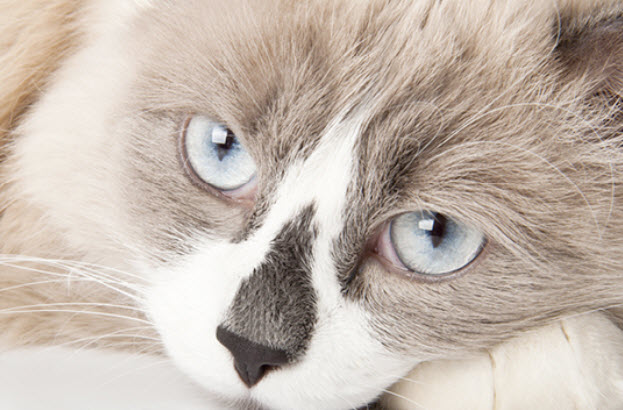 Much of what you can do at home to keep your cat happy and healthy is common sense, just like it is for people. Watch her diet, make sure she gets plenty of exercise, regularly brush her teeth and coat, and call us or a pet emergency hospital when something seems unusual (see “What to Watch For” below). Be sure to adhere to the schedule of examinations and vaccinations that we recommend for your pet. During your cat's exams, we’ll perform her necessary “check-ups” and test for diseases and conditions that are common in Rags. Another very important step in caring for your pet is signing her up for pet health insurance. There will certainly be medical tests and procedures she will need throughout her life and pet health insurance will help you cover those costs.
Much of what you can do at home to keep your cat happy and healthy is common sense, just like it is for people. Watch her diet, make sure she gets plenty of exercise, regularly brush her teeth and coat, and call us or a pet emergency hospital when something seems unusual (see “What to Watch For” below). Be sure to adhere to the schedule of examinations and vaccinations that we recommend for your pet. During your cat's exams, we’ll perform her necessary “check-ups” and test for diseases and conditions that are common in Rags. Another very important step in caring for your pet is signing her up for pet health insurance. There will certainly be medical tests and procedures she will need throughout her life and pet health insurance will help you cover those costs.
Routine Care, Diet, and Exercise
Build your pet’s routine care into your schedule to help your Doll live longer, stay healthier, and be happier during her lifetime. We cannot overemphasize the importance of a proper diet and exercise routine for your pet.
- Supervise your pet as you would a young child. Keep doors closed, pick up after yourself, and block off rooms as necessary. This will help keep her out of trouble, off of inappropriate surfaces for jumping, and away from objects she shouldn’t put in her mouth.
- She has long hair that will need brushing daily.
- Ragdolls have generally good teeth, and you can keep them perfect by brushing them at least twice a week!
- Check her ears weekly for wax, debris, or signs of infection and clean when necessary. Don’t worry—we’ll show you how!
- She needs daily play sessions that stimulate her natural desire to hunt and explore. Keep her mind and body active or she may develop behavior issues.
- Cats are meticulously clean and demand a clean litter box. Be sure to provide at least one box for each cat and scoop waste daily.
- It is important that your cat drinks adequate amounts of water. If she won’t drink water from her bowl try adding ice cubes or a flowing fountain.
- Feed a high-quality feline diet appropriate for her age.
- Exercise your cat regularly by engaging her with high-activity toys.
What to Watch For
An abnormal symptom in your pet could be just a minor or temporary issue, but it could also be the sign of serious illness or disease. Knowing when to seek veterinary help, and how urgently, is essential to taking care of your cat. Many diseases can cause cats to have a characteristic combination of symptoms, which together can be a clear signal that your Ragdoll needs help.
Office Calls
Give us a call for an appointment if you notice any of these types of symptoms:
- Change in appetite or water consumption
- Tartar build-up, bad breath, red gums, or broken teeth
- Itchy skin (scratching, chewing, or licking), hair loss, or areas of shortened fur
- Lethargy, mental dullness, or excessive sleeping
- Fearfulness, aggression, or other behavioral changes
- Small lumps or nodules, which may look red or swollen
Emergencies
Seek medical care immediately if you notice any of these signs:
- Scratching or shaking the head, tender ears, or ear discharge
- Cloudiness, redness, itching, or any other abnormality involving the eyes
- Inability or straining to urinate; discolored urine
- Weakness or exercise intolerance; rapid, labored, or open-mouth breathing; sudden-onset of weakness
- Sudden hind leg weakness or paralysis, labored breathing, collapse, weakness on one side of the body